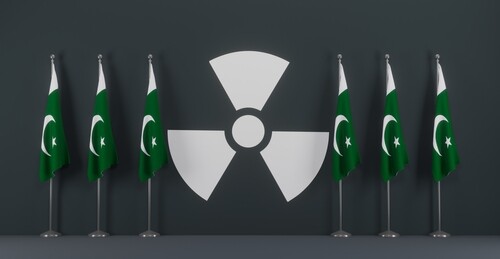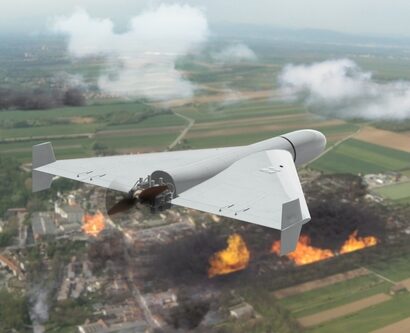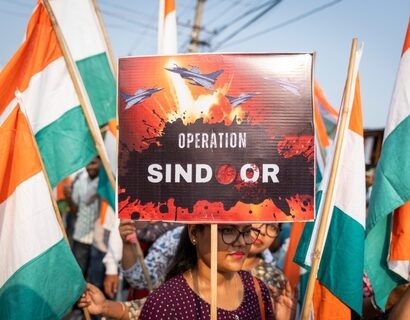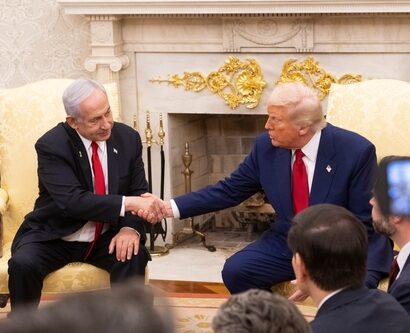Abstract: The World’s fifth nuclear power, Pakistan, faces threats to its nuclear security due to political and economic instability. This is rooted in doubt about whether Pakistan has the necessary security measures and resources to protect its nuclear arsenal from threats or if the country’s nuclear weapons are a dangerous liability to the world. Nevertheless, Pakistan has a credible nuclear security system that complies with international standards. Pakistan’s nuclear regime frequently revises its security procedures, having multiple layers of security protocols, advanced training centres, and international cooperation to secure its nuclear weapons effectively.
Problem statement: Is Pakistan’s nuclear security under threat due to its current political and economic instability? How effective are the measures in place to safeguard Pakistan’s nuclear assets?
So what?: International bodies and domestic authorities must bolster their collaboration with Pakistan’s nuclear regime to further enhance its formidable nuclear security framework. By fostering robust partnerships and providing sustained support to ensure the continued maintenance and advancement of Pakistan’s cutting-edge security measures, fortifying global nuclear safety.

Source: shutterstock.com/Fly Of Swallow Studio
Pakistan’s Nuclear Security Ranking
Pakistan is the world’s fifth-largest nuclear power. Pakistan’s global rankings indicate relative standing in terms of nuclear security compared to other countries.[1] Specifically, the security of facilities is ranked 32. This ranking suggests that Pakistan is placed 32nd among all the nuclear power states, for the security measures to protect nuclear facilities.[2] These facilities include nuclear power plants, research reactors, and any other installations that might handle or store nuclear materials. A rank of 32 implies that while Pakistan has established certain security protocols and measures, there may still be significant room for improvement in physical security, cybersecurity, personnel reliability, and protection against insider threats.[3] Secondly, the security of materials ranked 19 for the security of nuclear materials, which indicates that Pakistan has relatively stronger measures in place to secure nuclear materials compared to other countries. This includes securing highly enriched uranium (HEU) and plutonium, which can be used to make nuclear weapons. A higher ranking in this category reflects Pakistan’s efforts to implement effective controls, accounting, and protection measures to prevent theft or unauthorised access to these materials. While Pakistan has made substantial progress in securing its nuclear materials, there is still a need to strengthen the security of its facilities to enhance overall nuclear security.
While Pakistan has established certain security protocols and measures, there may still be significant room for improvement in physical security, cybersecurity, personnel reliability, and protection against insider threats.
Nuclear Security Risks in a Tumultuous Economic / Political Climate
Due to the current instability in the country, Pakistan’s nuclear security could be perceived as under threat due to the country’s unstable current political and economic situation. Pakistan’s nuclear security is being challenged due to its current instability, which primarily comes from several keys. The International Atomic Energy Agency (IAEA) and the Nuclear Threat Initiative (NTI) have expressed concerns about the stability of nuclear-armed states with internal political and economic challenges.[4], [5] These entities are vigilant about any potential risks associated with nuclear proliferation or theft, especially in regions with political instability. In the same vein, foreign governments and analysts in global security and non-proliferation perceive Pakistan’s nuclear security as challenging due to political turmoil and economic difficulties. Focusing on the potential for internal conflict, governance issues, or economic constraints to undermine the effectiveness of nuclear security measures.[6], [7] Media outlets[8] often highlight the potential vulnerabilities associated with nuclear security in politically unstable regions. NGOs[9] focused on peace, security, and non-proliferation, such as the Carnegie Endowment for International Peace,[10] raised alarms about the stability and security of nuclear arsenals in countries experiencing economic instability. In politically unstable regions, the legislation and regulations that govern nuclear power can be compromised, and the well-developed hierarchical control systems that secure nuclear assets can be derogated. Some economic factors could also impact the resources required to maintain and enhance security, including costs of training personnel and technological advancements.
Moreover, internal unrest and the presence of extremist groups pose additional risks, as they might exploit governance gaps. Extremist entities in Pakistan have posed ongoing challenges to the country’s nuclear security. While Pakistan has made significant strides in securing its nuclear arsenal and facilities, the persistent threat from extremist groups and internal instability continues to be a concern. Firstly, they have targeted vulnerable personnel within the nuclear establishment. These groups seek to gain access to sensitive information or nuclear materials by infiltrating or influencing insiders. Secondly, the porous nature of Pakistan’s borders and the presence of militant networks provide opportunities for smuggling and illicit trafficking of nuclear materials. Additionally, the ongoing political and economic instability can strain the resources and effectiveness of security measures, potentially creating gaps that these groups can exploit. One major method involves direct attacks on nuclear facilities. The attacks on the Sargodha missile storage facility, the Kamra airbase, and the Wah cantonment have highlighted vulnerabilities in Pakistan’s nuclear infrastructure. These attacks demonstrate how extremist groups can penetrate layers of security using tactics such as disguises, detailed intelligence, and coordinated assaults.[11]
The resurgence of the Tehrik-i-Taliban Pakistan (TTP),[12] particularly after the Taliban’s return to power in Afghanistan in 2021, has heightened security concerns. The TTP has intensified its attacks within Pakistan, targeting security forces and creating an atmosphere of insecurity that could potentially threaten nuclear sites if not adequately controlled. The attacks on the Sargodha missile storage facility, the Kamra airbase, and the Wah cantonment have highlighted vulnerabilities in Pakistan’s nuclear infrastructure. These attacks demonstrate how extremist groups can penetrate layers of security using tactics such as disguises, detailed intelligence, and coordinated assaults. The emphasis on secrecy over physical security has its drawbacks. While this approach aims to reduce visibility and, thus, vulnerability, it can backfire if insiders reveal sensitive information about nuclear sites and movements. This method of security relies heavily on preventing outside knowledge of nuclear operations, but insider collusion or breaches can significantly compromise these efforts.
The TTP has intensified its attacks within Pakistan, targeting security forces and creating an atmosphere of insecurity that could potentially threaten nuclear sites if not adequately controlled.
Islamic State of Khorasan Province ISKP[13] has also been active in Pakistan, carrying out several high-profile attacks. Their presence adds to the complex security landscape and raises concerns about the potential for coordinated attacks on critical infrastructure, including nuclear facilities. Furthermore, In April of 2022, the Prime Minister of Pakistan, Imran Khan, was ousted through a no-confidence vote.[14] This political upheaval led to widespread protests and demonstrations, creating a volatile environment. Political instability can strain government institutions, including those responsible for nuclear security, by diverting attention and resources from security tasks. Frequent changes in political leadership and cabinet reshuffles can disrupt the continuity and effectiveness of security policies. For example, changes in leadership delay or complicate the implementation of new security protocols necessary to address evolving threats. Additionally, the emphasis on secrecy over physical security has its drawbacks. While this approach aims to reduce visibility and, thus, vulnerability, it can backfire if insiders reveal sensitive information about nuclear sites and movements. This method of security relies heavily on preventing outside knowledge of nuclear operations, but insider collusion or breaches can significantly compromise these efforts.[15] Moreover, on the economic front, high inflation and mounting national debt have further strained the economy, potentially affecting budget allocations for defence and security, including nuclear security enhancements.[16]
Robust Regulatory Frameworks
Despite these challenges, Pakistan’s continuous adherence to international nuclear security standards, updates on its regulatory measures and active participation in global forums reduce the probability to a maximum extent with regard to the safety and security of its nuclear assets.[17] While extrapolating on these concerns, the reality on the ground is quite different regarding Pakistan’s nuclear security. Pakistan has a well-advanced and all-encompassing nuclear security regime in accordance with the standards of the International Atomic Energy Agency (IAEA)[18] and other international nuclear watchdog institutions. Pakistan’s nuclear regime comprises sophisticated legislation and a regulation system strengthened by entities such as the Pakistan Nuclear Regulatory Authority PNRA[19] that keeps developing regulation updates to ensure the best standards.
Pakistan has a well-advanced and all-encompassing nuclear security regime in accordance with the standards of the International Atomic Energy Agency and other international nuclear watchdog institutions.
Pakistan continues to engage in international legal engagements and upgrading its nuclear security regime. Having advanced multiple layers of defence[20] measures that consist of cyber threat protection, and it has established nuclear security training centres of excellence that are accredited by the IAEA. Pakistan actively cooperates with the IAEA and has gained immense experience in the implementation of nuclear security measures, which serves as a datum point for other countries while offering its experience on nuclear security. In addition, it actively participates in international nuclear cooperation, which entails sharing the Pakistani experience and receiving information about the experiences of other countries to further enhance the current nuclear security system.[21]
The PNRA regime is supported by a legislative and regulatory framework for the security of nuclear materials and radioactive substances facilities and activities; Pakistan’s standards and security measures are backed by strong institutions and a trained workforce, enabling these credentials to be implemented. The regulatory oversight provided by the PNRA plays a critical role in maintaining high standards of safety and security across all nuclear installations.[22]
Role of IAEA and NTI
Nuclear security is an important aspect of Pakistan’s’ Foreign Policy, evidenced by the various proactive engagements in international legal frameworks that manifest in its active participation in the global realm belonging to several transnational authorised structures, namely the Convention of the Physical Protection of Nuclear Materials and its amendment in the year 2005 of the IAEA’s Code of Conduct for the Safety and Security of Sources of Radioactive.
Moreover, Pakistan is also a member of the Nuclear Safety Convention and other international treaties in this respect to depict commitment towards nuclear norms of safety. Pakistan has aligned its measures with international standards, including the amended Convention on Physical Protection of Nuclear Material and Facilities (A/CPPNM) and the Nuclear Security Recommendations (INFCIRC/225/Revision 5).[23]
Pakistan has now opted for a multi-tiered security mechanism, setting up anti-threat layers to respond to and counter a broad range of threats, including cyber threats. This is because it has well-established structures in the command and control of the whole system. Setting up of centres of excellence, for instance, the Pakistan Center of Excellence for Nuclear Security PCENS [24] and the National Institute of Safety & Security (NISAS), was recently designated as the International Atomic Energy Agency (IAEA) Collaborating Centre for Education,[25] demonstrates the endeavour of Pakistan towards enhancing nuclear security education and training.[26]
Pakistan has now opted for a multi-tiered security mechanism, setting up anti-threat layers to respond to and counter a broad range of threats, including cyber threats.
These centres undertake professional development in nuclear security, physical protection, and personnel reliability, thereby strengthening the country’s capacity in nuclear security. Although the international community remains apprehensive over the safety of Pakistan’s nuclear stockpiles and their vulnerability to terrorist attack or proliferation, Pakistan’s civil nuclear security regime nonetheless bears a similarity to current global practice. By enhancing the internal counterterrorism efforts and attempting to place nuclear regulation under the government’s single authority, Pakistan has considerably added to the perceived effectiveness of its nuclear security measures.
Pakistani nuclear security measures have proved themselves to be quite effective over the years, becoming a massive and stringent system that is actively improving the outcomes across all sides of nuclear security in the country, specifically after the 1998 nuclear tests.[27] This regime is built upon three main pillars: Strict legal measures, many organisations involved in enforcing security legislation, and sophisticated systems to provide nuclear security. These regulatory bodies consists of the National Command Authority Act 2010, the Pakistan Nuclear[26] Regulatory Authority Ordinance 2001 and the Strategic Export Control Act of 2004. These Laws enable the National Command Authority to overall control and security of the nuclear assets of Pakistan, including safety and security measures in the physical domain.[28]
Actions by Pakistan’s Military and Intelligence Agencies
Global acknowledgement of Pakistan’s efforts towards enhancing nuclear security can also be seen from its better rankings in the NTI [29] Nuclear Security Index. In the latest assessment, Pakistan secured 100 per cent on the segment of ‘Domestic Commitments and Capacity,” this was with respect to full compliance with UNSCR 1540 and the existence of adequate domestic law.[30] These enhancements have been recognised by prominent nuclear scholars who corroborated Pakistan’s status as a responsible nuclear power with a stable and well-guarded nuclear arsenal.[31]
Nevertheless, Pakistan still suffers from external doubts arising from its past problems, such as the A. Q. Khan proliferation episode, notwithstanding the modernisation of the country’s strategic arsenal.[32] Such risks have been considerably reduced due to continuous reforms and transparent activities. Pakistan’s security policy for its nuclear arsenal has been very efficient and inclusive.
Bolstering Pakistan’s Security Infrastructure
Pakistan has multilayer nuclear security measures with features of prevention, detection, response, and material protection control and accounting programs. One of these is the creation of a Design Basis Threat (DBT),[33] which is a framework to apply in planning, designing, and scrutinising physical protection systems (PPS). This comprehensive approach includes stringent physical protection measures such as perimeter fencing, armed guards, and advanced surveillance systems. Personnel reliability programs involve rigorous vetting, continuous monitoring, and regular psychological evaluations. Digital information security measures include firewalls, intrusion detection systems, and regular security audits. Pakistan collaborates with international bodies like the IAEA, adhering to global standards and conventions. The country also emphasises emergency preparedness through crisis management plans, regular drills, and coordination with local and international agencies. Technological upgrades and research and development are continuously pursued to stay ahead of potential threats, ensuring a robust defence against a wide range of security challenges. It conveys the prevention of threats through the cooperation of different operators and regulators. The security infrastructure includes multi-layered border security electronic sensors, closed-circuit cameras, air defences, and counterintelligence teams.[34]
Technological upgrades and research and development are continuously pursued to stay ahead of potential threats, ensuring a robust defence against a wide range of security challenges.
Pakistan has established several vital organisations for strengthening nuclear security measures. For the security of all sensitive nuclear sites, the SPD’s Strategic Plans Division has a Security Division of 20,000 employees, which also has a quick reactionary force.[35] Moreover, the Pakistan Center of Excellence for Nuclear Security (PCENS) also has elaborate courses, including protective forces and physical protection, security and intelligence, and material control and accounting.[36]
To fight cyber threats, Pakistan, under Regulation 19 of PNRA Regulation 925,[37] has implemented stringent cybersecurity measures to protect computer communications and networks, reducing the risk of cyberattacks that could potentially compromise sensitive nuclear data or disrupt critical systems. By establishing a robust cybersecurity framework, Pakistan has improved its ability to detect, prevent, and respond to cyber threats. This has increased the resilience of nuclear facilities against potential cyber intrusions, thereby safeguarding nuclear assets and operations. Also, the Nuclear Emergency Management System has been developed to carry out actions in nuclear and radiological incidents involving the Nuclear and Radiological Emergency Support and Coordination Centre.[38] The Pakistan Atomic Energy Commission (PAEC) Ordinance of 1965 and the Pakistan Nuclear Safety and Radiation Protection Ordinance of 1984 form the backbone of the country’s nuclear regulatory environment.[39] These laws mandate the organisation and implementation of extensive security measures, ensuring that nuclear materials and facilities are well-protected.
Asma Khan Durrani is a scholar of Defense Strategic and Diplomatic Studies with a Master of Philosophy in International Relations. Her research interests are focused on global/regional security, counterterrorism/counterinsurgency operations, information warfare, arms control, foreign policy analysis and geopolitical dynamics of South Asia. The views contained in this article are the author’s own and do not represent the views of any associated institutions. Her work is recognised nationally and internationally. Published in – Author @ Modern Diplomacy. EU, @ Medium, @ Stratheia, @ Eurasia Review, @ Geopolitica.RU, @ Politics-dz, @ Pak Observer,@BeforeitsNews. The views contained in this article are the author’s alone.
[1] NPR, “Pakistan, The World’s Fifth Largest Nuclear Power,” February 03, 2011, https://www.npr.org/2011/02/03/133470765/pakistan-the-worlds-fifth-largest-nuclear-power#:~:text=Pakistan%2C%20The%20World’s%20Fifth%20Largest%20Nuclear%20Power%20The%20Washington%20Post,surpassing%20both%20Britain%20and%20France; Alexandra Sifferlin, “Pakistan Could Have the World’s Fifth Largest Nuclear Weapons Arsenal by 2025, Report Says,” Time, October 22, 2015, https://time.com/4082776/pakistan-report-nuclear-weapons-fifth-largest-2025/.
[2] Nuclear Threat Initiative (NTI), “Pakistan,” NTI Nuclear Security Index, https://www.ntiindex.org/country/pakistan/.
[3] Ibid.
[4] International Atomic Energy Agency (IAEA), “Country Report: Pakistan,” May 2023, https://www.iaea.org/sites/default/files/24/05/cn-321_pakistan.pdf.
[5] Nuclear Threat Initiative (NTI), “NTI Nuclear Security Index,” https://www.ntiindex.org/
[6] U.S. Department of State, “U.S. Imposes Sanctions on Suppliers to Pakistan’s Ballistic Missile Program,” February 24, 2023, https://www.state.gov/u-s-imposes-sanctions-on-suppliers-to-pakistans-ballistic-missile-program/
[7] Tahir Azad and Karl Dewey, “Understanding Pakistan’s Nuclear Security Regime,” Journal of Strategic Security 16, no. 4 (2023): 180-202, https://digitalcommons.usf.edu/jss/vol16/iss4/15; Asim Zia Umrani, “The Evolution of Nuclear Security Culture in Pakistan,” International Journal of Nuclear Security 5, no. 1 (2019), https://trace.tennessee.edu/cgi/viewcontent.cgi?article=1269&context=ijns; Henry Sokolski, “Nuclear Security in Pakistan: Separating Myth from Reality,” Arms Control Today, July/August 2009, https://www.armscontrol.org/act/2009-07/features/nuclear-security-pakistan-separating-myth-reality
[8] Frank Gardner, “Pakistan’s Nuclear Security Has Vulnerabilities: U.S.,” Reuters, February 04, 2011, https://www.reuters.com/article/world/middle-east/pakistan-s-nuclear-security-has-vulnerabilities-u-s-idUSTRE6115L8/
[9] “Pakistan’s Nuclear Bomb: A Story of Defiance, Deterrence and Deviance,” Carnegie India, June 2019, https://carnegieindia.org/events/2019/06/pakistans-nuclear-bomb-a-story-of-defiance-deterrence-and-deviance?lang=en¢er=russia-eurasia.
[10] Ibid.
[11] Combating Terrorism Center at West Point, “Terrorist Tactics in Pakistan Threaten Nuclear Weapons Safety,” last accessed July 29, 2024, https://ctc.westpoint.edu/terrorist-tactics-pakistan-threaten-nuclear-weapons-safety/.
[12] Bruce Riedel, “The Terrorist Threat to Pakistan’s Nuclear Weapons,” Combating Terrorism Centre at West Point, May 27, 2020, https://ctc.westpoint.edu/the-terrorist-threat-to-pakistans-nuclear-weapons/.
[13] Anthony H. Cordesman, “The Islamic State Threat to Pakistan: Trends and Scenarios,” Centre for Strategic and International Studies (CSIS), February 25, 2022, https://www.csis.org/analysis/islamic-state-threat-pakistan-trends-and-scenarios.
[14] Asif Shahzad, “Pakistan Parliament to Try Again to Vote to Oust PM Khan,” Reuters, April 09, 2022, https://www.reuters.com/world/asia-pacific/pakistan-parliament-try-again-vote-oust-pm-khan-2022-04-09/.
[15] “Nuclear Security in Pakistan: Reducing the Risks of Nuclear Terrorism,” Arms Control Association, March 2020, last accessed July 29, 2024, https://www.armscontrol.org/act/2020-03/features/nuclear-security-pakistan-reducing-risks-nuclear-terrorism.
[16] “Pakistan Sustained Its Nuclear Programme Despite Economic Turmoil: Top US Intelligence Official Tells Congress,” Economic Times, May 23, 2023, https://economictimes.indiatimes.com/news/defence/pakistan-sustained-its-nuclear-programme-despite-economic-turmoil-top-us-intelligence-official-tells-congress/articleshow/109338712.cms?from=mdr.
[17] International Atomic Energy Agency (IAEA), “International Conference on Nuclear Security 2024,” https://www.iaea.org/events/icons2024.
[18] Farhan Bokhari, “Securing Pakistan’s Nuclear Arsenal,” Journal of Strategic Security 7, no. 4 (2014), https://digitalcommons.usf.edu/cgi/viewcontent.cgi?article=2121&context=jss.
[19] David Shambaugh, “Pakistan’s Nuclear Security: A Case Study,” EastWest Institute, January 2007, https://ciaotest.cc.columbia.edu/pbei/ewi/0001609/f_0001609_822.pdf.
[20] Yamina Ghazala, “Pakistan’s Evolving Nuclear Security Measures,” Institute of Strategic Studies Islamabad (ISSI), August 30, 2023, https://issi.org.pk/wp-content/uploads/2023/08/IB_Ghazala_Aug_30_2023.pdf.
[21] Pakistan Nuclear Regulatory Authority (PNRA), “Reports and Publications,” https://www.pnra.org/report.html; Pakistan Nuclear Regulatory Authority (PNRA), “Competency Management,” https://www.pnra.org/cmpt-mgmt.html.
[22] International Atomic Energy Agency, “Nuclear Security Recommendations on Physical Protection of Nuclear Material and Nuclear Facilities (INFCIRC/225/Revision 5),” IAEA Nuclear Security Series No. 13, IAEA, Vienna (2011), https://doi.org/10.61092/iaea.ko2c-dc4q.
[23] International Atomic Energy Agency (IAEA), “Pakistan’s National Centre of Excellence Contributes to Sustaining Nuclear Security,” https://www.iaea.org/newscenter/news/pakistans-national-centre-of-excellence-contributes-to-sustaining-nuclear-security.
[24] Pakistan Nuclear Regulatory Authority, “The National Institute of Safety and Security (NISAS) Designated as an IAEA Collaborating Centre for Nuclear Security, Including Education, Training, and Technical Support,” https://pnra.org/NISAS-IAEA.html#:~:text=The%20National%20Institute%20of%20Safety,ceremony%20on%20Sept%2030%2C%202022.
[25] International Atomic Energy Agency (IAEA), “International Conference on Nuclear Security 2024,” https://www.iaea.org/events/icons2024.
[26] “IAEA Grants Collaborating Center Status to Pakistan’s NISAS,” The Diplomatic Insight, last modified July 29, 2024, https://thediplomaticinsight.com/iaea-grants-collaborating-center-status-to-pakistans-nisas/.
[27] Pakistan Nuclear Regulatory Authority, Ordinance 2001 (Amended), https://www.pnra.org/upload/legal_basis/Ordinance%202001(Amennded).pdf.
[28] International Atomic Energy Agency, “Agreement of 5 November 1979 Between the Agency and the Government of the Republic of Belarus for the Application of Safeguards in Connection with the Treaty on the Non-Proliferation of Nuclear Weapons,” INFCIRC/636, Vienna: IAEA, 2004, https://www.iaea.org/sites/default/files/publications/documents/infcircs/2004/infcirc636.pdf
[29] Nuclear Threat Initiative (NTI), “Pakistan,” NTI Nuclear Security Index, https://www.ntiindex.org/country/pakistan/.
[30] United Nations Office for Disarmament Affairs (UNODA), “United Nations Security Council Resolution 1540,” https://disarmament.unoda.org/wmd/sc1540/.
[31] Toby Dalton, “The Wisdom of a Grand Nuclear Bargain with Pakistan,” Atlantic Council, January 30, 2023, https://www.atlanticcouncil.org/commentary/event-recap/the-wisdom-of-a-grand-nuclear-bargain-with-pakistan/; Pia Malhotra Kamboj, “Pakistan’s Nuclear Security,” Institute for Defence Studies and Analyses (IDSA), 2013, https://www.idsa.in/system/files/OP_PakistansNuclearSecurity.pdf; Jayshree Bajoria, “Pakistan’s Nuclear Security: Separating Myth from Reality,” Arms Control Today, July/August 2009, https://www.armscontrol.org/act/2009-07/features/nuclear-security-pakistan-separating-myth-reality; Syed Manzar Ahmed, “A Review of Pakistan’s Nuclear Security,” Journal of Strategic Security 8, no. 1 (2015), https://www.jstor.org/stable/43828317; Samina Ahmed, “A Review of Pakistan’s Nuclear Security Culture,” Academia.edu, 2023, https://air.unimi.it/bitstream/2434/981048/6/Ahmed%2Breview%281%29.pdf; Farhan Bokhari, “Securing Pakistan’s Nuclear Arsenal,” Journal of Strategic Security 7, no. 4 (2014), https://digitalcommons.usf.edu/cgi/viewcontent.cgi?article=2121&context=jss; Bruce Riedel, “Avoiding Armageddon: America, India, and Pakistan to the Brink and Back,” Stanford University Press, 2013, https://www.sup.org/books/title/?id=21098; Asim Zia Umrani, “The Evolution of Nuclear Security Culture in Pakistan,” International Journal of Nuclear Security 5, no. 1 (2019), https://trace.tennessee.edu/cgi/viewcontent.cgi?article=1269&context=ijns.
[32] Ghazala, Yamina, “Pakistan’s Evolving Nuclear Security Measures,” Institute of Strategic Studies Islamabad (ISSI), August 30, 2023, https://issi.org.pk/wp-content/uploads/2023/08/IB_Ghazala_Aug_30_2023.pdf.
[33] Nuclear Threat Initiative (NTI), “U.S. Nuclear Modernization and Security: Policy Implications of Integrating Digital Technology,” https://www.nti.org/analysis/articles/u-s-nuclear-modernization-security-policy-implications-of-integrating-digital-technology/.
[34] Brookhaven National Laboratory (BNL), “Integrated Instrumentation Program,” https://www.bnl.gov/instrumentation/integrated/.
[35] Nuclear Threat Initiative (NTI), “Strategic Plans Division (SPD),” https://www.nti.org/education-center/facilities/strategic-plans-division-spd/; International Atomic Energy Agency (IAEA), “Pakistan’s National Centre of Excellence Contributes to Sustaining Nuclear Security,” https://www.iaea.org/newscenter/news/pakistans-national-centre-of-excellence-contributes-to-sustaining-nuclear-security.
[36] Pakistan Nuclear Regulatory Authority (PNRA), “Regulation on Physical Protection of Nuclear Material and Nuclear Facilities,” PAK/925. Islamabad: PNRA, 2018, https://www.pnra.org/upload/legal_basis/regulations/PAK-925.pdf; International Atomic Energy Agency (IAEA), “Nuclear Security Recommendations on Physical Protection of Nuclear Material and Nuclear Facilities (INFCIRC/225/Revision 5),” Vienna: IAEA, 2011, https://www-pub.iaea.org/mtcd/publications/pdf/pub1613_web.pdf.
[37] International Atomic Energy Agency (IAEA), “Emergency Preparedness and Response (EPR),” https://www.iaea.org/topics/emergency-preparedness-and-response-epr.
[38] International Atomic Energy Agency (IAEA). Regulatory Framework for Nuclear Security in Pakistan, https://inis.iaea.org/collection/NCLCollectionStore/_Public/21/072/21072764.pdf; International Atomic Energy Agency (IAEA), “Advancing Nuclear Security: Evaluating Progress and Setting Future Directions,” Vienna: IAEA, 2022, https://www-pub.iaea.org/MTCD/publications/PDF/PUB1918_web.pdf
[39] International Atomic Energy Agency, Code on the Safety of Nuclear Power Plants: Operation (Safety Series No. 50-C-O (Rev. 1)), Vienna: IAEA, 1988, https://inis.iaea.org/collection/NCLCollectionStore/_Public/21/072/21072764.pdf.




